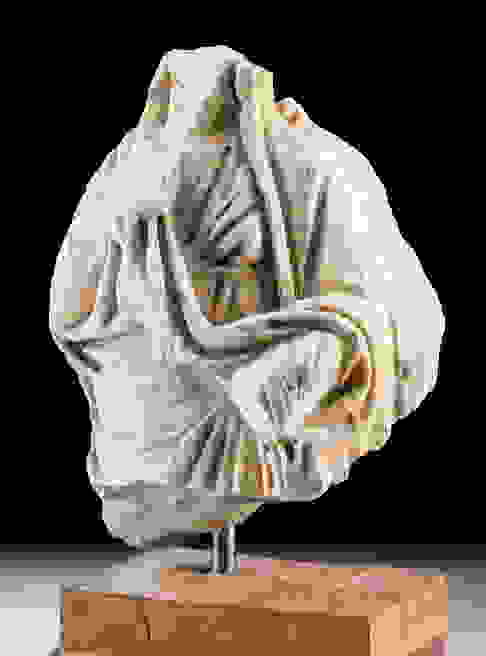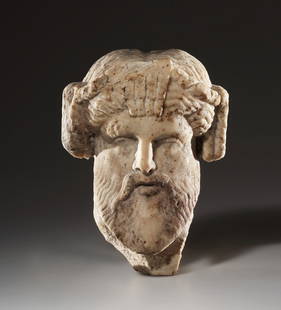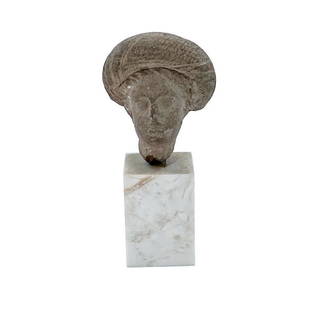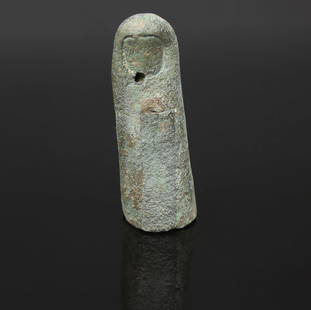
Roman Marble Torso Draped Female Figure
Similar Sale History
View More Items in Statues & StatuettesRelated Statues & Statuettes
More Items in Ancient Greek & Roman Statues & Statuettes
View MoreRecommended Sculptures & Carvings
View More







Item Details
Description
Roman, Imperial period, ca. 1st to 3rd century CE. A fabulous marble torso of a female heavily draped in robes that cascade in billowing folds down her body, belted just beneath her breasts and a flowing himation that envelops her neck, shoulders, and arms. Roman sculptors took the idea of depicting heavily draped women from Greek statues of the Hellenistic period. With the fabric concealing the figure's body, the clothing becomes the focus of the piece with its folds, creases, and contrasting textures, as seen here. The woman holds one arm up to her chest, likely to softly touch the hood of her himation, while the other falls down to her hips, creating a dynamic pose that is only accentuated by the voluminous pleats of her drapery. The bashful stance of this statue is known as the Pudicitia type - a Hellenistic style developed from the 3rd to 2nd centuries BCE and named for the goddess of modesty and chastity, Pudicitia. Size: 9.3" L x 11.6" W x 15.6" H (23.6 cm x 29.5 cm x 39.6 cm); 18" H (45.7 cm) on included custom stand.
The pose is also known as the Braccio Nuovo type, after the draped female statue located in the New Wing of the Vatican Museums under accession number MV.2284.0.0. The grandeur of this statue suggests that it may have been part of a public monument.
Marble statuary, reliefs, and cladding were ubiquitous in the Roman world, as the remains of the preserved cities at Herculaneum and Pompeii demonstrate. Their sculpture was intended to conjure human vitality, and was inspired by the works of Polykleitos, who became the model to which sculptors aspired in Greco-Roman art as well as later Western European art. Greco-Roman statuary, unlike that of the other Mediterranean civilizations like Egypt, Persia, etc., celebrated the naturalistic human form. This included representations of their gods who appear as if living people, dressed as if they are elite citizens. For example, the famous statue of Hades with Cerberus, his three-headed dog, today on display at the Archaeological Museum of Crete, has an extremely realistic quality despite its fantastical nature, down to the details on each dog head. This suggests an intriguing, more personal relationship with the gods rather than the more abstract or magical portrayals of other contemporary societies.
Provenance: East Coast collection, New York Gallery, New York City, New York, USA, acquired before 2010
All items legal to buy/sell under U.S. Statute covering cultural patrimony Code 2600, CHAPTER 14, and are guaranteed to be as described or your money back.
A Certificate of Authenticity will accompany all winning bids.
We ship worldwide to most countries and handle all shipping in-house for your convenience.
#177236
The pose is also known as the Braccio Nuovo type, after the draped female statue located in the New Wing of the Vatican Museums under accession number MV.2284.0.0. The grandeur of this statue suggests that it may have been part of a public monument.
Marble statuary, reliefs, and cladding were ubiquitous in the Roman world, as the remains of the preserved cities at Herculaneum and Pompeii demonstrate. Their sculpture was intended to conjure human vitality, and was inspired by the works of Polykleitos, who became the model to which sculptors aspired in Greco-Roman art as well as later Western European art. Greco-Roman statuary, unlike that of the other Mediterranean civilizations like Egypt, Persia, etc., celebrated the naturalistic human form. This included representations of their gods who appear as if living people, dressed as if they are elite citizens. For example, the famous statue of Hades with Cerberus, his three-headed dog, today on display at the Archaeological Museum of Crete, has an extremely realistic quality despite its fantastical nature, down to the details on each dog head. This suggests an intriguing, more personal relationship with the gods rather than the more abstract or magical portrayals of other contemporary societies.
Provenance: East Coast collection, New York Gallery, New York City, New York, USA, acquired before 2010
All items legal to buy/sell under U.S. Statute covering cultural patrimony Code 2600, CHAPTER 14, and are guaranteed to be as described or your money back.
A Certificate of Authenticity will accompany all winning bids.
We ship worldwide to most countries and handle all shipping in-house for your convenience.
#177236
Condition
Fragment of a larger piece with nicks, chips, and abrasions as shown, all commensurate with age. Nice remaining detail and light earthen deposits in areas. Permanently affixed to custom stand.
Buyer's Premium
- 27.5%
Roman Marble Torso Draped Female Figure
Estimate $4,000 - $6,000
5 bidders are watching this item.
Get approved to bid.
Shipping & Pickup Options
Item located in Louisville, CO, usOffers In-House Shipping
Payment
Accepts seamless payments through LiveAuctioneers

Auction Curated By

Owner/Executive Director, Antiquities & Pre-Columbian Art

PhD. Art History, Director, Fine & Visual Arts
TOP


















































































![NEAPOLITAN FONDERIA AMODIO GRAND TOUR BRONZE SCULPTURE POMPEII NARCISSUS: Neapolitan patinated bronze sculpture, "Narcissus," after the antique discovered in Pompeii, signed on integral base F.ria Amodio [Fonderia Amodio], Napoli (Michele Amodio, Italian, 19th c.), approx 2](https://p1.liveauctioneers.com/21/330096/177971597_1_x.jpg?height=310&quality=70&version=1715874767)